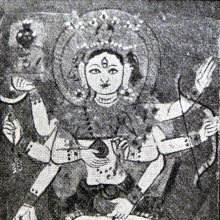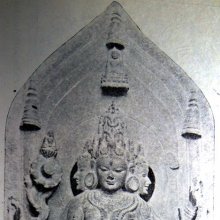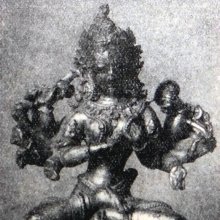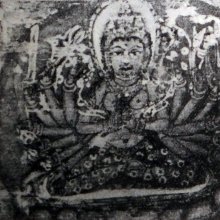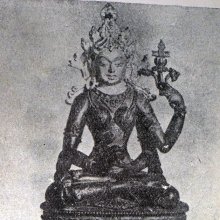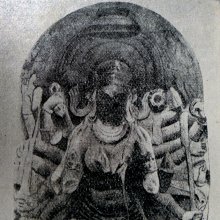Dharini, Dhārinī, Dhāriṇī: 19 definitions
Introduction:
Dharini means something in Buddhism, Pali, Hinduism, Sanskrit, Jainism, Prakrit. If you want to know the exact meaning, history, etymology or English translation of this term then check out the descriptions on this page. Add your comment or reference to a book if you want to contribute to this summary article.
Images (photo gallery)
In Hinduism
Purana and Itihasa (epic history)
Source: archive.org: Puranic EncyclopediaDhāriṇī (धारिणी).—A daughter born to the Manes (Pitṛs) created by Brahmā, by their wife Svadhā. Dhāriṇī had an elder sister named Menā. Both were expounders of the Vedas and of good qualities. (Viṣṇu Purāṇa, Aṃśa 1, Chapter 10).
Source: archive.org: Shiva Purana - English TranslationDhāriṇī (धारिणी) (Cf. Dhārin) refers to “she who supports” (a particular system of philosophy), according to the Śivapurāṇa 2.3.13 (“Śiva-Pārvatī dialogue”).—Accordingly, as Śiva said to Pārvatī: “O Pārvatī, O upholder of the Sāṃkhya system [i.e., sāṅkhya-dhāriṇī], if you say so, O sweet-voiced lady, you render me unforbidden service every day. If I am the Brahman, the supreme lord, unsullied by illusion, comprehensible through spiritual knowledge and the master of illusion what will you do then?”.
Source: Cologne Digital Sanskrit Dictionaries: The Purana IndexDhārinī (धारिनी).—A Pitṛkanyā, a daughter of Svadhā;1 mindborn daughter of Barhiṣadas, became the wife of Meru; son Mandara, and three daughters, Velā, Niyatī and Āyatī;2 a brahmavādinī.3
- 1) Bhāgavata-purāṇa IV. 1. 64.
- 2) Brahmāṇḍa-purāṇa II. 13. 30ff; Vāyu-purāṇa 30. 28; 33. 4; 62. 192.
- 3) Viṣṇu-purāṇa I. 10. 19.
Dhāriṇi (धारिणि) refers to one of the two daughters of Pitṛ and Svadhā: one of the twenty-four daughters of Dakṣa and Prasūti, according to the Vaṃśa (‘genealogical description’) of the 10th century Saurapurāṇa: one of the various Upapurāṇas depicting Śaivism.—Accordingly, Ākūti was married to Ruci and Prasūti to Dakṣa. Dakṣa produced in Prasūti twenty-four daughters. [...] [Svadhā was given to Pitṛs.] Pitṛ and Svadhā had two daughters—Menā and Dhāriṇi. Dhāriṇi was married to Meru and had a son named Mandara and three daughters—Velā, Niyati and Āyati.

The Purana (पुराण, purāṇas) refers to Sanskrit literature preserving ancient India’s vast cultural history, including historical legends, religious ceremonies, various arts and sciences. The eighteen mahapuranas total over 400,000 shlokas (metrical couplets) and date to at least several centuries BCE.
Shaktism (Shakta philosophy)
Source: Google Books: ManthanabhairavatantramDhāriṇī (धारिणी) (Cf. Dhārin) refers to “she who bears” (e.g., she who bears a form), according to the Kularatnoddyota, one of the earliest Kubjikā Tantras.—Accordingly, “(Now) listen, O goddess, to how you should be contemplated in the Transmission of the Aged. Residing in the Wheel you bear a form [i.e., mūrti-dhāriṇī] according to the distinction between gross and subtle. Residing in the middle of the Wheel of the Command, (you) burn with radiant rays (of energy). Inflammed, (you) possess garlands of flames and, of the nature of Sound, (you are) without fault. Seated within the movement of Haṃsa (the vital breath), (you) possess manifest energies (while) residing in the unmanifest. [...]”.
Source: Brill: Śaivism and the Tantric Traditions (shaktism)Dhāriṇī (धारिणी) (Cf. Dhārin) refers to “she who carries (attributes in one’s hand)”, according to the King Vatsarāja’s Pūjāstuti called the Kāmasiddhistuti (also Vāmakeśvarīstuti), guiding one through the worship of the Goddess Nityā.—Accordingly, “[...] I take refuge with the goddesses of becoming minute and other great accomplishments for the sake of success. They hold wish-fulfilling jewels in both hands. They are moon-crested, three-eyed, and red in complexion. I revere Brahmāṇī and the other mother-goddesses. They carry a skull-bowl and red lily in their hands (dhāriṇī—kapālotpaladhāriṇī), their bodies are dark-colored like the leaves of bamboo, and they are clad in lovely [red] clothes resembling bandhūka flowers. [...]”.

Shakta (शाक्त, śākta) or Shaktism (śāktism) represents a tradition of Hinduism where the Goddess (Devi) is revered and worshipped. Shakta literature includes a range of scriptures, including various Agamas and Tantras, although its roots may be traced back to the Vedas.
Yoga (school of philosophy)
Source: eScholarship: Gāruḍa Medicine (yoga)Dhāriṇī (धारिणी) refers to “supporting” and represents one of the Pañcadhāraṇā or “five-fold meditation on the elements”, according to the Vivekamārtaṇḍa (or Gorakṣaśataka), one of the earliest text on Haṭhayoga.—Accordingly, “Stabilizing, supporting (dhāriṇī), and burning as well as desiccating; this is the five-fold meditation on the elements”.

Yoga is originally considered a branch of Hindu philosophy (astika), but both ancient and modern Yoga combine the physical, mental and spiritual. Yoga teaches various physical techniques also known as āsanas (postures), used for various purposes (eg., meditation, contemplation, relaxation).
In Buddhism
Tibetan Buddhism (Vajrayana or tantric Buddhism)
Source: archive.org: The Indian Buddhist IconographyDhāriṇī (धारिणी) refers to a peculiar kind of Buddhist literature which is supposed to generate great mystic power if repeated continually for a long time. They are short works mostly composed of meaningless syllables, sometimes revealing traces of a language now defunct. [...] The Buddhists believe that when the Dhāriṇī is repeated in deep meditation for a long time with concentration and faith, the mantra vibrations grossen themselves in the concrete form of a deity which the worshipper visualizes, and thus obtains siddhi or success. Once realized, the deity never leaves the worshipper and gives him everything that he desires.
The Niṣpannayogāvalī acknowledges altogether twelve Dhāriṇī deities and gives their descriptions. These Dhāriṇīs look alike when represented and they are usually two-armed, holding the Viśvavajra in the right hand and their special symbols in the left.
The names of the twelve Dhāriṇīs as given in the Niṣpannayogāvalī are these:—
- Sumati,
- Ratnolkā,
- Uṣṇīṣavijayā,
- Mārī,
- Parṇaśabarī,
- Jāṅgulī,
- Anantamukhī,
- Cundā,
- Prajñāvardhanī,
- Sarvakarmāvaraṇaviśodhanī,
- Akṣayajñānakaraṇḍā
- Sarvabuddhadharma-Koṣavatī.
These Dhāriṇīs are collectively assigned to the Dhyāni Buddha Amoghasiddhi, and are described later in this book.—Amongst the Dhāriṇī deities Uṣṇīṣavijayī, Jāṅgulī, Parṇaśabarī and Cundā are popular, and there are sādhanas and images of these deities in art. But they represent nothing more than the respective vidyās or mantras of which they are the embodiments.
The Dhāriṇīs are mostly unmeaning strings of words which are required to be kept inmemory, so that they may be repeated at will for the purpose of developing psychic powers. The Dhāriṇīs sometimes reveal traces of alanguage now unknown. Several Dhāriṇīs are recorded in the Sādhanamālā. Niṣpannayogāvalī spells the word somewhat differently as Dhāriṇīs and recognizes a group of Twelve Dhāriṇīs. In the process of deification these Dhāriṇīs also became deities with form, colour and symbols. The Dhāriṇīs collectively are placed in the family of the Dhyāni Buddha Amoghasiddhi of green colour.

Tibetan Buddhism includes schools such as Nyingma, Kadampa, Kagyu and Gelug. Their primary canon of literature is divided in two broad categories: The Kangyur, which consists of Buddha’s words, and the Tengyur, which includes commentaries from various sources. Esotericism and tantra techniques (vajrayāna) are collected indepently.
In Jainism
General definition (in Jainism)
Source: Wisdom Library: JainismDhāriṇī (धारिणी) is the wife of Cakṣuṣmān, who is a kulakara (law-giver) according to Digambara sources, while Śvetāmbara names his wife as Candrakānta. The kulakaras (similair to the manus of the Brahmanical tradition) figure as important characters protecting and guiding humanity towards prosperity during ancient times of distress, whenever the kalpavṛkṣa (wishing tree) failed to provide the proper service.
These law-givers and their wifes (e.g., Dhāriṇī) are listed in various Jain sources, such as the Bhagavatīsūtra and Jambūdvīpaprajñapti in Śvetāmbara, or the Tiloyapaṇṇatti and Ādipurāṇa in the Digambara tradition.
Source: archive.org: Trisastisalakapurusacaritra1) Dhāriṇī (धारिणी) is the wife of Viśākhabhūti and mother of Viśvabhūti, according to chapter 4.1 [śreyāṃsanātha-caritra] of Hemacandra’s 11th century Triṣaṣṭiśalākāpuruṣacaritra: an ancient Sanskrit epic poem narrating the history and legends of sixty-three illustrious persons in Jainism.—Accordingly:—“Now in the city Rājagṛha King Viśvanandin had a son, Viśākhanandin, by his wife Priyaṅgu. Viśvanandin had a younger brother, crown prince, Viśākhabhūti, intelligent, heroic, well-bred, politic. Marīci’s jīva became the son of Viśākhabhūti by his wife Dhāriṇī because of rewards gained in a former birth. His parents gave him the name Viśvabhūti and he gradually grew up, cherished by nurses. He learned all the arts and acquired all the virtues and gradually attained youth—the embodied ornament of the body”.
2) Dhāriṇī (धारिणी) is the name of the Yakṣiṇī (i.e., Śāsanadevatās, ‘messenger-deities’) associated with Ara-nātha, according to chapter 6.2 [aranātha-caritra].
3) Dhāriṇī (धारिणी) is the wife of king Bala from Vītaśoka, according to chapter 6.6 [śrī-mallinātha-caritra].
4) Dhāriṇī (धारिणी) is the wife of king Jitaśatru from Kāmpīlya, according to chapter 6.6.
5) Dhāriṇī (धारिणी) is the wife of king Jitaśatru from Śrāvastī, according to the Jain Ramayana and chapter 7.5 [The kidnapping of Sītā].—Accordingly, as sage Sugupta narrated to Rāma: “Formerly there was a city, Kumbhakārakaṭa, and its king, Daṇḍaka. At that time in Śrāvastī there was King Jitaśatru; his wife was Dhāriṇī, and their son was Skandaka. They had a daughter, Purandarayaśas, and Daṇḍaka, the lord of Kumbhakārakaṭa, married her. [...]”.
Source: academia.edu: Tessitori Collection IDhāriṇī (धारिणी) is the wife of king Jitaśatru, according to he Draupadīcopaī (dealing with the lives of Jain female heroes), which is included in the collection of manuscripts at the ‘Vincenzo Joppi’ library, collected by Luigi Pio Tessitori during his visit to Rajasthan between 1914 and 1919.—The story (of the Draupadīcopaī ) is explicitly taken from the sixth aṅga of the Śvetāmbara canon, the Jñātādharmakathāṅga, chapter 16 (see vs. 6 above). The beginning of the story itself is hardly legible because of the bad condition of the first page. It starts with a king Jitaśatru, his queen Dhāriṇī and the clever minister Abhayakumāra.

Jainism is an Indian religion of Dharma whose doctrine revolves around harmlessness (ahimsa) towards every living being. The two major branches (Digambara and Svetambara) of Jainism stimulate self-control (or, shramana, ‘self-reliance’) and spiritual development through a path of peace for the soul to progess to the ultimate goal.
Languages of India and abroad
Sanskrit dictionary
Source: DDSA: The practical Sanskrit-English dictionaryDhāriṇī (धारिणी).—The earth.
Source: Cologne Digital Sanskrit Dictionaries: Shabda-Sagara Sanskrit-English DictionaryDhāriṇī (धारिणी).—f. (-ṇī) 1. The earth. 2. The silk cotton tree, (Bombax heptaphyllum.) E. dhṛ, and ṇini aff.
Source: Cologne Digital Sanskrit Dictionaries: Monier-Williams Sanskrit-English Dictionary1) Dhariṇi (धरिणि):—[from dhara] m. Name of an Āgastya, [Pravara texts]
2) Dhāriṇī (धारिणी):—[from dhārin > dhāra] f. the earth, [cf. Lexicographers, esp. such as amarasiṃha, halāyudha, hemacandra, etc.] (cf. bhūta-)
3) [v.s. ...] Name of a daughter of Sva-dhā, [Bhāgavata-purāṇa] (cf. raṇī)
4) [v.s. ...] Name of a deity, [Jaina literature]
5) [v.s. ...] of the wife of Agni-mitra, [Mālavikāgnimitra]
6) [v.s. ...] of other women, [Hemacandra’s Pariśiṣṭaparvan]
7) [v.s. ...] [plural] a collect. Name of the 74 wives of the gods, [Vahni-purāṇa]
Source: Cologne Digital Sanskrit Dictionaries: Yates Sanskrit-English DictionaryDhāriṇī (धारिणी):—(ṇī) 3. f. The earth; the silk-cotton tree (Bombax heptaphyllum).
Source: DDSA: Paia-sadda-mahannavo; a comprehensive Prakrit Hindi dictionary (S)Dhariṇī (धरिणी) in the Sanskrit language is related to the Prakrit word: Dhariṇī.
[Sanskrit to German]
Sanskrit, also spelled संस्कृतम् (saṃskṛtam), is an ancient language of India commonly seen as the grandmother of the Indo-European language family (even English!). Closely allied with Prakrit and Pali, Sanskrit is more exhaustive in both grammar and terms and has the most extensive collection of literature in the world, greatly surpassing its sister-languages Greek and Latin.
Prakrit-English dictionary
Source: DDSA: Paia-sadda-mahannavo; a comprehensive Prakrit Hindi dictionaryDhariṇī (धरिणी) in the Prakrit language is related to the Sanskrit word: Dhariṇī.
Prakrit is an ancient language closely associated with both Pali and Sanskrit. Jain literature is often composed in this language or sub-dialects, such as the Agamas and their commentaries which are written in Ardhamagadhi and Maharashtri Prakrit. The earliest extant texts can be dated to as early as the 4th century BCE although core portions might be older.
Kannada-English dictionary
Source: Alar: Kannada-English corpusDhāriṇi (ಧಾರಿಣಿ):—
1) [noun] the earth.
2) [noun] a territory being under the sway of one independent government; a state; a country.
3) [noun] (yoga.) one of the sub-nāḍi (hidden carrier of energy in the body) situated around main Suṣumanā nāḍi.
Kannada is a Dravidian language (as opposed to the Indo-European language family) mainly spoken in the southwestern region of India.
See also (Relevant definitions)
Starts with: Dharinidhava, Dharinidhavate, Tarini.
Ends with (+41): Ajnadharini, Akarshanadharini, Asidharini, Avadharini, Ayudhadharini, Bhutadharini, Camaradharini, Chatradharini, Chihnadharini, Chinhadharini, Cihnadharini, Cundadharini, Dandadharini, Dhairyadharini, Dhyanadharini, Dipadharini, Dipikadharini, Ghantadharini, Jamintarini, Kapaladharini.
Full-text (+87): Cihnadharini, Dharin, Bhutadharini, Lokadharini, Dipikadharini, Vasudharini, Karnadharini, Vishvadharini, Sarvabuddhadharma, Akshayajnanakaranda, Sarvakarmavaranavishodhani, Mittatarni, Sumati, Mari, Anantamukhi, Prajnavardhani, Vela, Shivadharini, Ayati, Camaradharini.
Relevant text
Search found 29 books and stories containing Dharini, Dhārinī, Dhāriṇī, Dhariṇi, Dhariṇī, Dhāriṇi; (plurals include: Dharinis, Dhārinīs, Dhāriṇīs, Dhariṇis, Dhariṇīs, Dhāriṇis). You can also click to the full overview containing English textual excerpts. Below are direct links for the most relevant articles:
The Indian Buddhist Iconography (by Benoytosh Bhattachacharyya)
Figure 161-164 - Emanations of Vairocana: Cundā
Stupas in Orissa (Study) (by Meenakshi Chauley)
Emanations of Vairocana < [Chapter 5]
Minor Structural Stupas at Lalitagiri < [Chapter 4]
Trishashti Shalaka Purusha Caritra (by Helen M. Johnson)
Part 2: Birth of Rājīniatī < [Chapter VIII - The episode of Sāgaracandra]
Part 4: Early life of Kaṃsa < [Chapter II - Marriages of Vasudeva with maidens]
Part 10: Incarnation as Viśvabhūti < [Chapter I - Previous births of Mahāvīra]
Garga Samhita (English) (by Danavir Goswami)
Verse 1.12.46 < [Chapter 12 - Description of Śrī Nanda’s Festival]
Verse 1.12.45 < [Chapter 12 - Description of Śrī Nanda’s Festival]
Verse 6.7.19 < [Chapter 7 - The Marriage of Śrī Rukmiṇī]
